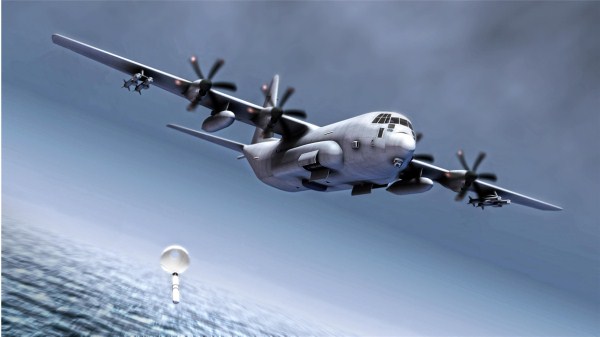Lockheed Martin's Sea Hercules unveiled
Lockheed Martin has responded with the Sea Hercules to the Indian Navy's Request for Information (RFI) for Medium Range Maritime Reconnaissance aircraft, as first reported by StratPost.
US defense and aviation giant Lockheed Martin unveiled the maritime version of its successful C-130 Hercules medium airlifter at the Singapore Air Show in February 2012. Vice President of Business Development, George Standridge, pointed to a tiny inset image in a slide during a presentation made at the show, calling it the 'Sea Herc'.
"You take the well–proven airframe and program that the C-130J brings and you essentially import the capabilities of the P-3 mission systems that's flying internationally and you end up with the Sea Hercules," he said.
Lockheed Martin has responded with the Sea Hercules to the Indian Navy's Request for Information (RFI) for Medium Range Maritime Reconnaissance aircraft, as first reported by StratPost.
Standridge went on, "And the beauty of this type of airplane – it's a four-engine turbo-prop – it means time on station, it means the ability to prosecute targets and potential threats as well as shipping across a broad spectrum of any type of ocean mass. We're spending a lot of time talking with new potential customers now in an effort to be responsive to that market as they look at the continued emphasis on maritime patrol surveillance as well as Anti Submarine Warfare."
StratPost dug a little deeper, asking about the genesis of the new variant and elicited an emailed response from Lockheed Martin about the configuration. The company says it has already built a 'maritime configuration for the C-130 that the US Coast Guard currently operates'.
"We are expanding the Maritime Patrol and Reconnaissance (MPRA) capability at the request of several international customers to include full Anti Submarine Warfare (ASW). The Lockheed Martin P-3 Orion MPRA operated by the US Navy and twenty domestic and international operators provides the modern mission system and sensors which can be palletized and transferred to the SC-130J Sea Herc. The C-130J operates in many different configurations in addition to its primary role as a combat delivery vehicle. Adding full ASW capability to the C-130J is a logical response to meet an international demand for a long range, long time on station, turbo prop multi-role aircraft," said the company.
The aircraft isn't a mere concept, says the company. "With the exception of some test and development required for the full ASW configuration, the majority of SC-130J capability has been developed and is currently in operation. LM has developed many operational mission configurations for the C-130 based on customer requests. LM has considered the development of full ASW for the C-130J over the last ten years, but recent customer demand has moved this past the concept stage into development and test."
Lockheed Martin says that 'Not counting the systems brought in for Maritime Patrol and ASW and production and after production mods, there is no difference between a SC-130J Sea Herc and C-130J Super Hercules'.
So what does make it different? "The ASW capabilities of the P-3 Orion including torpedoes, forward firing weapons and sonobuoy delivery have been incorporated into the SC-130J in-addition to the mission system and sensors," says the company, also pointing out, "In-addition, the C-130J has a 60,000 flt hour rated center wing box providing the ideal ruggedness required to meet the turbulence often encountered in low altitude operations."
This does not mean the Sea Hercules will necessarily amount to the Orion's systems onboard a Super Hercules. "The capability of the Sea Herc including ISR/ASW systems can be determined by the customer. While we are utilizing the latest P-3 mission system and software as a constant, the customer can tailor the sensors they desire to meet their operational needs," says Lockheed Martin.
But the Sea Hercules will bring the advantage of variable configuration over the P-3 Orion.
The major difference in capability between the two aircraft is the P-3 Orion is a dedicated MPRA. The SC-130J Sea Herc with its palletized mission system can be used as a dedicated MPRA but offers the option of easily removing the palletized mission system providing combat delivery capability.
"The ability to change from one mission configurations to another is not offered in the P-3, not to mention the economies gained in a single TMS airframe," says the company.
Lockheed Martin thinks the four turbo-prop engines of the platform make the aircraft a strong candidate for the Indian Navy. "The Sea Herc is designed to be a scalable MRMR MPRA adaptable to IN requirements. On station time is a critical component in the MPRA mission area and something the Sea Herc excels at when compared to a twin engine alternative. Payload capability, the ability to carry everything you need to execute the mission is another consideration when determining the right MPRA," they say.
With the Indian Air Force (IAF) already inducting C-130J Super Hercules aircraft, Lockheed Martin thinks the Sea Hercules would be a good fit for the Indian Navy, saying, "Once again, staying with a similar TMS which is operated by the IAF may be a consideration offering a potential sustainment economy."
The company rolled off it's 2,400th C-130 in 2011 and currently has 319 orders, of which they've delivered around 250.
Lockheed Martin's Sea Hercules unveiled | StratPost


